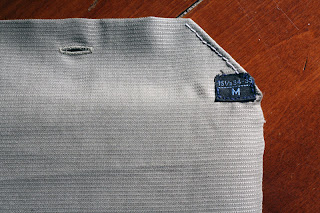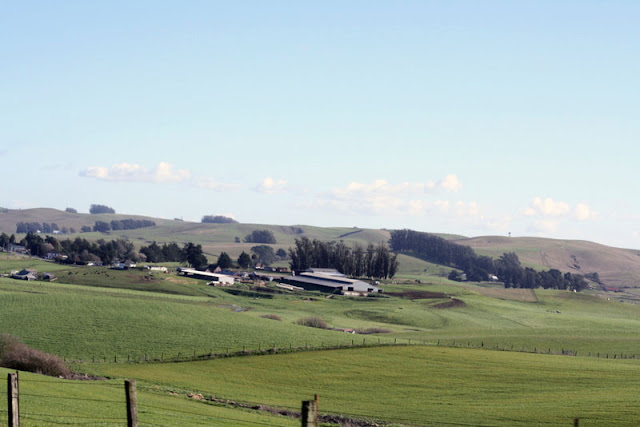Perfected pizza recipe
February 28, 2013
Pizza was the one meal I could make, back before I could cook. And thanks to my Italian grandmother, I was very particular about how to make it, as my friends in high school can attest. No pre-shredded mozzarella, a very thin crust, and definitely no store-bought pasta sauce. I also wasn't very adventurous. Cheese pizza was just perfect, thank you very much.
A decade later (scary!), I'm still particular with my pizza, but I have ventured away from all cheese all the time. Ben and I have had plenty of chances to perfect our perfect recipe because I couldn't stand the disgusting lump of dough and cheese that passed for pizza in Argentina. I also started making my own dough because pre-made dough is unheard of there.
For one of the most amazing pizzas you've ever had, consider the following recipes.
Whole wheat pizza dough
Adapted from Pizza, my Christmas present from Ben
Note: This recipe makes three thin-crust pizzas. Pizza dough keeps nicely frozen, but if you don't want to make this much, you can always reduce the ingredients accordingly.
4 teaspoons active dry yeast
1 cup lukewarm water
2 2/3 cups whole-wheat flour
2 2/3 cups bread or all-purpose white flour (bread flour makes the crust crispier; last time I split it half and half because I'm carefully rationing my bread flour)
1 teaspoon salt
2 tablespoons extra virgin olive oil
Place yeast in a small bowl and add warm water. Stir gently until yeast has dissolved. Set aside until frothy, about 10 minutes.
Combine flours and the salt in a medium bowl. Pour in the yeast mixture and oil. Add up to 1 cup of lukewarm water to obtain a fairly sticky dough. (Note: I almost never need anywhere near this much water. Start with no more than 1/4 cup and evaluate from there.)
Knead the dough for 8-10 minutes on a lightly floured work surface. When it is firm and no longer sticks to your hands, bang it down hard a couple of times to develop the gluten.
Place in a large oiled bowl and cover with a cloth. Set aside to rise until doubled in bulk, about one to two hours.
Tomato sauce
Adapted from Smitten Kitchen
I couldn't believe how delicious this tomato sauce was the first time I made it. I haven't used it in combination with the other recipes listed here because it takes a little time and we're impatient. But I imagine it would be equally delicious. If you're pressed for time, just drain the canned tomatoes and spice with salt, pepper, garlic powder and oregano. Last time I even added some nutmeg (I grabbed the wrong spice jar).
28 oz of diced tomatoes (1 can), drained
2 tablespoons olive oil
2 cloves of garlic, minced
Pinch of red pepper flakes
Splash of white wine
1/2 teaspoon sugar
3/4 teaspoon salt
Heat olive oil over medium heat. Add the garlic and stir for a minute with a wooden spoon. Add the red pepper flakes and stir it for anther minute. You do not want the garlic to brown. Add the drained tomatoes, along with the wine, sugar and salt.
Let the sauce simmer for about 30 minutes, stirring occasionally, until the tomatoes break down. Carefully taste without burning your tongue and adjust seasonings, if necessary.
(You can also make this with fresh roma tomatoes by following the recipe linked above, but I haven't tried since tomatoes aren't in season.)
Arugula Topping with Lemon-Parmesan Dressing
Adapted from Bon Appetit
1/6 cup freshly grated Parmesan cheese
2 1/2 tablespoons extra-virgin olive oil
1 tablespoon fresh lemon juice
1/2 teaspoon finely grated lemon peel
Baby arugula
Blend first 4 ingredients in processor or mason jar. Season dressing with salt and pepper. Toss arugula with enough dressing to coat.
Assembly instructions
Whole wheat pizza dough (see above)
Tomato sauce (see above)
Shredded mozzarella
Minced garlic gloves
Sliced red onion
Arugula topping (see above)
Preheat oven to about 450 degrees Fahrenheit. I always used to call my grandmother to ask the appropriate temperature for baking pizza and she always told me, "It depends how you like."
Roll out the dough. Transfer to a cornmeal-sprinkled baking sheet or pizza stone. Cornmeal is a new addition for me, and I like the texture it gives to the bottom of the pizza.
If you like your pizza crispy, you can bake the dough for 3-5 minutes before adding the rest of the toppings. Add the tomatoes, mozzarella, garlic and red onion. Bake for 8-12 minutes, or until the cheese and underside look cooked.
Top off with the arugula and cook for one more minute to slightly warm the arugula.
Serve immediately. And enjoy.
Let me know what you think! What are your favorite pizza recipes?
- Steph
Fancy dinner recipes
February 22, 2013
Before we decided to go out for Valentine's Day, I had devised a four-course fancy dinner menu. I was so excited about this meal that I still wanted to make it, which I did on Tuesday. Above is the menu, followed by recipes and photos.
Brie and Apple Canapés
Adapted from Whole Foods
2 tart apples, cored and sliced into eighths
1 tablespoon melted butter
1 tablespoon brown sugar
1/2 wheel brie, sliced
16 baguette slices
Preheat oven to 375°F. Toss apple slices with melted butter and brown sugar. Bake apples until tender, about 20 minutes.
Arrange Brie evenly over the bread slices and top with the apple slices. If desired, broil one to two minutes until cheese is just melted. Serve immediately.
Artichoke and Arugula Salad with Parmesan
Adapted from Bon Appetit
1 tablespoon orange juice
1/2 tablespoon red wine vinegar
1/2 teaspoon Dijon mustard
2.5 tablespoons extra-virgin olive oil
1/2 can artichoke hearts, thinly sliced
3 oz arugula
Parmesan cheese, shaved
Whisk orange juice, vinegar, and mustard in small bowl to blend. Gradually whisk in oil. Season vinaigrette to taste with salt and pepper. Can be made 1 day ahead. Cover and refrigerate.
Combine artichokes, arugula, and Parmesan in large bowl. Drizzle with vinaigrette and toss to coat.
Caramelized Shallots
Adapted from Smitten Kitchen
2/3 pound fresh shallots, peeled, with roots intact
1 tablespoon sugar
1 tablespoon good red wine vinegar
1/4 teaspoon kosher salt
1/4 teaspoon freshly ground black pepper
1 tablespoon chopped fresh flat-leaf parsley
Preheat the oven to 400 degrees F.
Melt the butter in a frying pan, add the shallots and sugar, and toss to coat. Cook over medium heat for 10 minutes, tossing occasionally, until the shallots start to brown. Add the vinegar, salt, and pepper and toss well.
Transfer shallots and sauce into saute pan and roast for 15 to 30 minutes, depending on the size of the shallots, until they are tender. Season, to taste, sprinkle with parsley, and serve hot.
Vanilla Roasted Pears
Adapted from Smitten Kitchen
1 tablespoon unsalted butter
1/8 cup sugar
1 teaspoon vanilla extract (or vanilla bean, if you have it)
3 slightly-under-ripe, fragrant, medium pears, peeled if desired, halved though the stem and cored
1 tablespoon lemon juice
2 tablespoons water
1 tablespoon unsalted butter
Preheat oven to 375°F. Place the sugar in a small bowl and stir in vanilla extract.
Arrange the pears in a large baking dish, cut-side up. Drizzle the lemon juice evenly over the fruit, then sprinkle with the sugar. Pour the water into the dish. Dot each pear with some butter.
Roast the pears 30 minutes brushing them occasionally with the pan juices. Turn the pears over and continue roasting, basting once or twice, until tender and caramelized, 25 to 30 minutes longer (if the pears are small, test for doneness after 35 or 40 minutes of cooking; a paring knife poked into the thickest part of one should meet with no resistance).
All of the above recipes make roughly two servings. And if you decide to make anything, keep in mind that post-Argentina I have a decidedly relaxed attitude toward following recipes exactly. I probably fudged many of these amounts so don't take them too seriously.
Ben just got a new iPhone, so we wanted to compare the quality of the photos between his iPhone camera and my Canon EOS Rebel XS. His photos are on the left, mine on the right.
Obviously our food photography needs a little work. But it was delicious.
- Steph
Photos: Best motorcycling roads
February 21, 2013
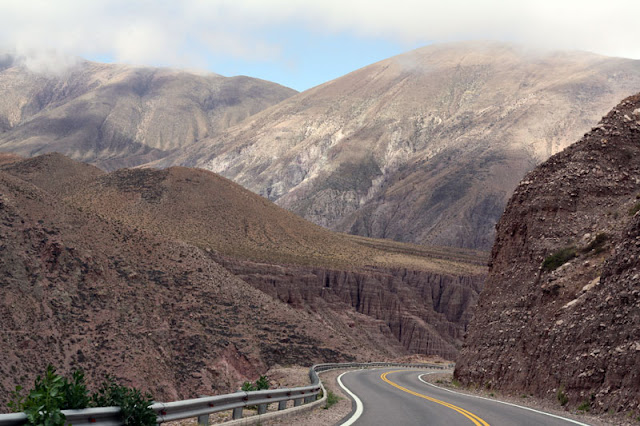 |
| Road to the salt flats — Jujuy, Argentina |
In November 2011, even though I had spent a total of four hours ever on a motorcycle, Ben and I set off on an eight-day, 4000-kilometer motorcycle journey across Argentina. I came back from that trip a convert to motorcycling, promising to repeat the experience in other corners of the world. I loved the closeness to the road and the visceral thrill of leaning into every curve. What I didn't realize at the time, and what I have now come to appreciate, is that northwest Argentina was a gorgeous, incomparable and enchanting introduction to motorcycling.
We climbed through a cloud forest, drove through vineyards flanked by towering mountains, and wove our way through desert valleys and mountaintop salt flats. We've ridden a lot in California in the last several months, and only now have I realized that motorcycling doesn't have to be as captivating as I found it that first time in Argentina. Some roads continue straight for miles, others are bounded by unending trees, and many are so poorly paved that you feel like a sack of potatoes on the back of a pickup truck.
Here's a look back at the best of Argentina's motorcycling roads, from Buenos Aires to the Salinas Grandes and back. All photos by me and Ben, unless otherwise noted.
 |
| Salinas Grandes — Jujuy, Argentina (photo by relapsed nun) |
 |
| Ruta 157 — Santiago del Estero (or Tucuman), Argentina |
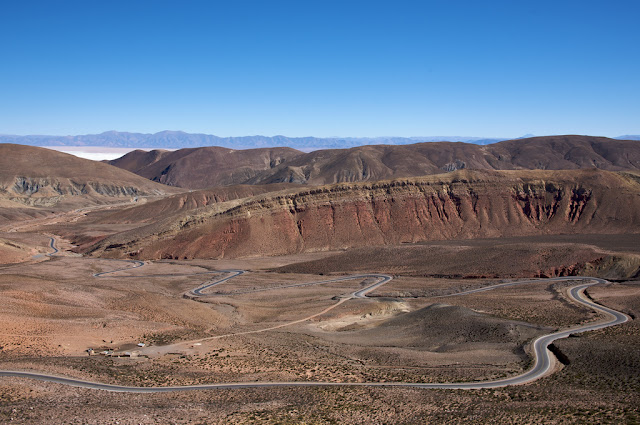 |
| Road to the salt flats — Jujuy, Argentina (photo by dirkoneill) |
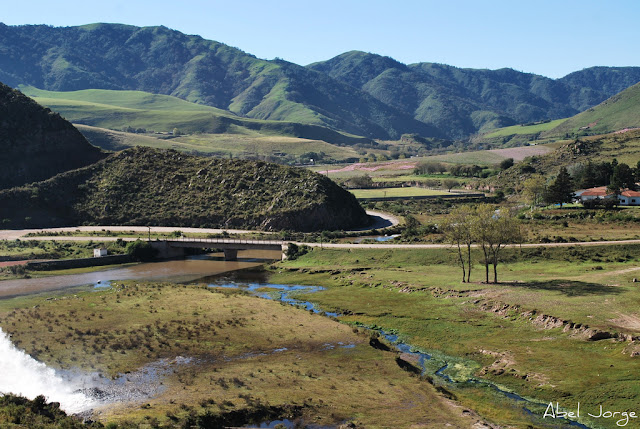 |
| Tafi del Valle — Tucuman, Argentina (photo by Abel Jorge) |
 |
| Quebrada de Las Conchas — Salta, Argentina |
 |
| Road to the salt flats — Jujuy, Argentina |
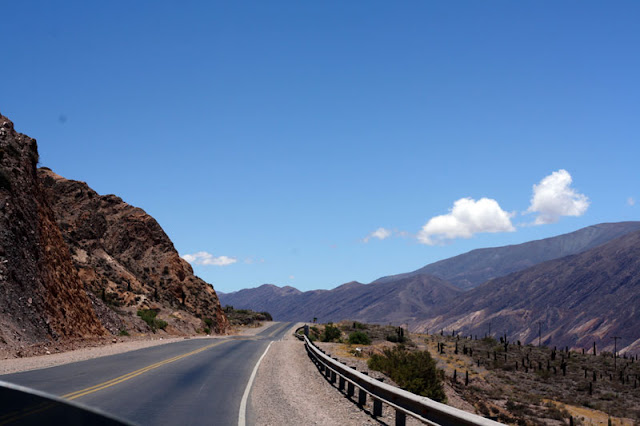 |
| Quebrada de Humahuaca — Jujuy, Argentina |
 |
| A sense of the scale, that's the road cutting across the bottom of the photo — Jujuy, Argentina |
 |
| Pozo Hondo — Santiago del Estero, Argentina |
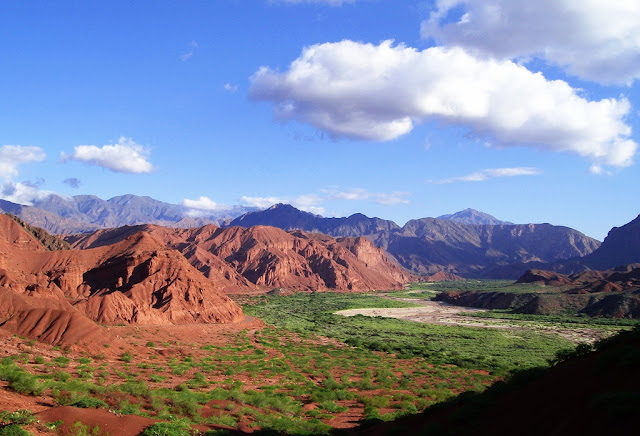 |
| Valles Calchaquies — Salta, Argentina (photo by jlborelli) |
Of course, that's not to say that California doesn't have its fair share of amazing motorcycle roads. More on that later.
- Steph
Switching from Android to iPhone
February 20, 2013
I've been an Android user since 2009, when the first Motorola Droid came out. I didn't want an iPhone because Apple locked it down so much: They have to approve every app in the App Store, they have to approve every library that developers use, and apps have limited access to the rest of the system. Android was the open alternative to the iPhone and its app ecosystem (with every major app eventually being built for both systems) was a close match for Apple's. As a programmer using open-source software all the time, I was philosophically partial to Android. The Droid's killer app was turn-by-turn navigation from Google Maps, which I used all the time on the road, and I live in Google's cloud.
I don't remember much from the Droid mark 1, but it couldn't have been too bad, because I upgraded to the Motorola Droid 3 in August 2011, before we moved to Argentina. It was a good option because it was a world phone — CDMA for Verizon at home and GSM-compatible for the rest of the world — and I was able to connect it to an Argentine phone+data plan. (We put "dumb" phones on the U.S. lines to keep them active for $10/month with Steph's parents' family plan.)
I never liked the Droid 3 much, though. It was slow and buggy from the beginning. The camera app crashed from day one and Motorola was slow to release updates. A few months ago I rooted it and wiped it clean to try to clean out the bloat, but it quickly got slow again. The process of taking a picture — turn it on, open the camera app, snap a picture, view the picture, share it — could take three minutes. Every little interaction lagged. Occasionally I'd have to make an important call and it would completely crap out.
The problem was, I had gotten it on a standard Verizon subsidized plan (where the monthly fee basically includes a high interest rate on the phone), and they only let you upgrade every 20 months. But I really didn't want to wait until April. It was getting absurd, being an engineer with a dysfunctional smartphone.
Also by this point, I had become pretty disillusioned with Android. It's really open in name only: Each manufacturer builds its own closed system on top of the open one. Motorola had neglected the Droid 3, with the last official update based on Android 2.3, from early 2011. After rooting it, I tried to install custom ROMs, custom distributions created in the open-source community, but none of them supported the phone's hardware, so basic features like the camera didn't work.
The mobile developers at work confirmed that this isn't a problem only with old models: The latest Samsung Galaxy models have all kinds of "special" bugs. Some manufacturers use their own libraries for things as basic as screen rotation. So Android developers have to buy 100 devices and test their app on every single one. (And a 2011 model like the Droid3 won't be one of those 100.) Most people obviously can't afford to do that, so apps just don't work. The newer the phone, the more likely apps are to break on it, because developers probably haven't gotten to test it yet.
So I decided to switch to iOS. I've been a Mac user since 2008 and love Apple's design aesthetic. Their complete end-to-end control — they design the chips, the screen, the camera, and the operating system — means there are far fewer points of failure, and they can test all of them. The iOS developers at work like that each version of their app takes a week to get to the App Store, because it guarantees a baseline of quality.
Set on an iPhone 5, I started exploring alternative pricing models to Verizon's contract plans. I wrote here about various options I found. The plan I decided to go with was T-Mobile's $30/month pre-paid plan, with unlimited data ("first 5 GB up to 4G speeds," then 3G), unlimited SMS, and only 100 minutes of talking per month. That balance is pretty much exactly what I need, and the price is awesome.
Learn more: Prepaid plan options with the iPhone 5
I've had the new phone for two days and I love it so far. I've installed all the same apps and a bunch more, and there's no lag anywhere. Everything just feels smooth and polished. I love the built-in video calling with FaceTime. The quality trickles down: the NY Times app on Android, for example, is slow to update and slow to respond to clicks; the same app on the iPhone is slick. I was getting 12Mbps download speeds downtown, which seems pretty fast. Integration with Google cloud services is basically as good as Android's. I watched Breaking Bad on the subway this morning and the picture was beautiful.
Android's not going anywhere, obviously; I just think it'll mostly capture the lower end of the market, the way Blackberry used to do (or the way Windows does with PCs). That "lower end" is probably 80 percent of the market (especially abroad), so it's enormous, and will give Apple plenty of healthy competition. But at the top of the line, for sheer quality, I've now confirmed with first-hand experience what I've read for a while, that Apple has a huge lead. It's nice to join the club.
- Ben
I don't remember much from the Droid mark 1, but it couldn't have been too bad, because I upgraded to the Motorola Droid 3 in August 2011, before we moved to Argentina. It was a good option because it was a world phone — CDMA for Verizon at home and GSM-compatible for the rest of the world — and I was able to connect it to an Argentine phone+data plan. (We put "dumb" phones on the U.S. lines to keep them active for $10/month with Steph's parents' family plan.)
I never liked the Droid 3 much, though. It was slow and buggy from the beginning. The camera app crashed from day one and Motorola was slow to release updates. A few months ago I rooted it and wiped it clean to try to clean out the bloat, but it quickly got slow again. The process of taking a picture — turn it on, open the camera app, snap a picture, view the picture, share it — could take three minutes. Every little interaction lagged. Occasionally I'd have to make an important call and it would completely crap out.
The problem was, I had gotten it on a standard Verizon subsidized plan (where the monthly fee basically includes a high interest rate on the phone), and they only let you upgrade every 20 months. But I really didn't want to wait until April. It was getting absurd, being an engineer with a dysfunctional smartphone.
Also by this point, I had become pretty disillusioned with Android. It's really open in name only: Each manufacturer builds its own closed system on top of the open one. Motorola had neglected the Droid 3, with the last official update based on Android 2.3, from early 2011. After rooting it, I tried to install custom ROMs, custom distributions created in the open-source community, but none of them supported the phone's hardware, so basic features like the camera didn't work.
The mobile developers at work confirmed that this isn't a problem only with old models: The latest Samsung Galaxy models have all kinds of "special" bugs. Some manufacturers use their own libraries for things as basic as screen rotation. So Android developers have to buy 100 devices and test their app on every single one. (And a 2011 model like the Droid3 won't be one of those 100.) Most people obviously can't afford to do that, so apps just don't work. The newer the phone, the more likely apps are to break on it, because developers probably haven't gotten to test it yet.
So I decided to switch to iOS. I've been a Mac user since 2008 and love Apple's design aesthetic. Their complete end-to-end control — they design the chips, the screen, the camera, and the operating system — means there are far fewer points of failure, and they can test all of them. The iOS developers at work like that each version of their app takes a week to get to the App Store, because it guarantees a baseline of quality.
Set on an iPhone 5, I started exploring alternative pricing models to Verizon's contract plans. I wrote here about various options I found. The plan I decided to go with was T-Mobile's $30/month pre-paid plan, with unlimited data ("first 5 GB up to 4G speeds," then 3G), unlimited SMS, and only 100 minutes of talking per month. That balance is pretty much exactly what I need, and the price is awesome.
Learn more: Prepaid plan options with the iPhone 5
I've had the new phone for two days and I love it so far. I've installed all the same apps and a bunch more, and there's no lag anywhere. Everything just feels smooth and polished. I love the built-in video calling with FaceTime. The quality trickles down: the NY Times app on Android, for example, is slow to update and slow to respond to clicks; the same app on the iPhone is slick. I was getting 12Mbps download speeds downtown, which seems pretty fast. Integration with Google cloud services is basically as good as Android's. I watched Breaking Bad on the subway this morning and the picture was beautiful.
Android's not going anywhere, obviously; I just think it'll mostly capture the lower end of the market, the way Blackberry used to do (or the way Windows does with PCs). That "lower end" is probably 80 percent of the market (especially abroad), so it's enormous, and will give Apple plenty of healthy competition. But at the top of the line, for sheer quality, I've now confirmed with first-hand experience what I've read for a while, that Apple has a huge lead. It's nice to join the club.
- Ben
Prepaid plan options with the iPhone 5
I recently got an iPhone 5 after four years as an Android user. In the process I also switched from a Verizon contract which subsidized the phone, to an up-front retail phone with a pre-paid T-Mobile plan, and I'll save a lot of money over the long run that way.
I did a bunch of research to find the right plan, so if you're trying to do something similar, you might find this useful.
I'm not a fan of two-year contracts to start with, and while I have no problem with Verizon per se, their policy of not allowing early upgrades without paying the contract cancelation penalty — around $180 in my case, for the remaining six months on the contract — gave me less incentive to stick with them, since I'd have to pay that anyway.
The NYT had a story in December about T-Mobile's upcoming iPhone 5 pricing: They weren't going to subsidize the phone, but their monthly fee was lower, so for some use cases, it made more sense to pay $650 up front for the device. I read about Walmart offering a similar plan. GigaOm had an article about "off-contract" options; demand for this up-front payment structure is clearly growing. Around the same time, a colleague at work realized that he rarely makes phone calls, and switched to using an iPod Touch with a $50/m mobile wifi hotspot. I realized I don't make a lot of phone calls either, and when I do, I can easily use Skype.
The plan I went with was T-Mobile's $30/month pre-paid plan, with unlimited data ("first 5 GB up to 4G speeds," then 3G), unlimited SMS, and only 100 minutes of talking per month. That balance is pretty much exactly what I need, and the price is awesome.
You can see the cost comparison, spread over two years, on the spreadsheet here. Here's a summary:
Getting it hooked up was a little tricky: The $30/m plan is only available online, but you can't get "nanoSIMs" online, only the larger "microSIMs". After first thinking I had been lied to at the T-Mobile store (which told me to go home and buy the plan online), I realized how the game works: Sign up with a microSIM, take it to the store, and they'll slice it down to a nano. (It's just extra plastic around the same chip. You could probably cut it at home but it's less risky to let them do it.) They don't advertise that you can do this, but they don't exactly hide it, either.
I'd like to see this kind of pricing model become more popular. But psychologically, people are scared off by the initial price tag and don't think long-term, so I doubt Verizon's side business of phone loans will go away any time soon.
- Ben
I did a bunch of research to find the right plan, so if you're trying to do something similar, you might find this useful.
I'm not a fan of two-year contracts to start with, and while I have no problem with Verizon per se, their policy of not allowing early upgrades without paying the contract cancelation penalty — around $180 in my case, for the remaining six months on the contract — gave me less incentive to stick with them, since I'd have to pay that anyway.
The NYT had a story in December about T-Mobile's upcoming iPhone 5 pricing: They weren't going to subsidize the phone, but their monthly fee was lower, so for some use cases, it made more sense to pay $650 up front for the device. I read about Walmart offering a similar plan. GigaOm had an article about "off-contract" options; demand for this up-front payment structure is clearly growing. Around the same time, a colleague at work realized that he rarely makes phone calls, and switched to using an iPod Touch with a $50/m mobile wifi hotspot. I realized I don't make a lot of phone calls either, and when I do, I can easily use Skype.
The plan I went with was T-Mobile's $30/month pre-paid plan, with unlimited data ("first 5 GB up to 4G speeds," then 3G), unlimited SMS, and only 100 minutes of talking per month. That balance is pretty much exactly what I need, and the price is awesome.
You can see the cost comparison, spread over two years, on the spreadsheet here. Here's a summary:
- Starting a new Verizon monthly plan, with a data cap and a subsidized iPhone 5, would cost around $2828 over 2 years.
- Walmart's plan, with a bullshit terms of service and unlimited data only in name (it's actually throttled over a low cap), would cost $1890.
- Buying a retail CDMA iPhone and using it with a Verizon family plan would cost $1710.
- Retail GSM iPhone, T-Mobile's $30/month plan, $1530.
For my low-talk needs, it was a no-brainer. T-Mobile has good coverage in the Bay Area. Since it's pre-paid, if I don't like T-Mobile, I can switch to AT&T or one of the GSM virtual operators. (Note if you're doing your own research: The CDMA/Verizon model iPhone is also GSM compatible, but it's not clear if it works with 4G on GSM, or just 3G; I got conflicting information about this.) Alternatively, if I need to use my phone as a wifi hotspot, or I need to make more calls, I can upgrade to a $50/m or $60/m plan for a month and then go back.
Getting it hooked up was a little tricky: The $30/m plan is only available online, but you can't get "nanoSIMs" online, only the larger "microSIMs". After first thinking I had been lied to at the T-Mobile store (which told me to go home and buy the plan online), I realized how the game works: Sign up with a microSIM, take it to the store, and they'll slice it down to a nano. (It's just extra plastic around the same chip. You could probably cut it at home but it's less risky to let them do it.) They don't advertise that you can do this, but they don't exactly hide it, either.
I'd like to see this kind of pricing model become more popular. But psychologically, people are scared off by the initial price tag and don't think long-term, so I doubt Verizon's side business of phone loans will go away any time soon.
- Ben
An improved Sonoma experience
February 19, 2013
If you recall, we didn't come away that impressed the last time we went to Sonoma. We liked the downtown area, but the motorcycle riding and scenery were lackluster. We promised at the time that we would return soon, and an olive oil festival last weekend seemed the perfect opportunity.
Rather than heading straight to Sonoma, a 50-mile drive on boring highways, we devised our own route that took us through a valley over toward Point Reyes before cutting back to Petaluma and on to Sonoma (map at the bottom). The first part took us through suburbia, but before long we escaped the strip malls and stop lights and entered farm country. We have traversed this area several times now (see here and here) and the landscape doesn't change much: rolling hills, long winding curves and lots of cows and horses. But the scenery, rather than beckoning boredom, has a mesmerizing effect and keeps us coming back.
 |
| Leaving the city |
 |
| Nicasio Valley Road in Marin County |
Even better, it was a balmy 68 degrees outside and wildflowers have started to bloom in the fields, which made for a much prettier ride than the one we did in December. We arrived in downtown Sonoma for lunch, too hungry to continue to the olive oil event at one of the vineyards. Instead, we ate and decided to explore the town of Sonoma. (Any suggestions for favorite affordable hotels near the town? We would love to come back for a weekend, but not for $300/night.)
By chance we wandered into the Charles Creek Vineyards tasting room. This was our fourth California wine tasting and though we bought a bottle from each of the previous wineries, in none of those cases did we come away impressed by the entire flight of wines. That wasn't the case at Charles Creek, which was affordable, generous with its pours and, most importantly, delicious.
We started with a 2011 Rosé from Napa made with Syrah grapes. Our pourer described it as "dry to the bone, as rosé should be." Ben and I were both immediately impressed. (I like good rosés — I have fond memories of a day spent walking around Palermo capped off by a bottle of Bodega Caelum Rosé.) We then tried a 2009 Chardonnay from the Russian River Valley and a 2010 Chardonnay from Sonoma County. Interestingly, these two wines were made exactly the same — same fermentation process, same oak, same aging, etc. The only variation was the grapes themselves, which were grown in different regions, and the two wines could not have been more different. Finally, we ended the whites with a 2008 Chardonnay from Sangiacomo Vineyard. According to our pourer, this wine is designed to be aged, unlike most California Chardonnays, which are meant to be drank young, with minimal subtlety and strong tones of fruit and oak.
Over the course of the tasting, which also included three Cabernet Sauvignons and a port, we absorbed some interesting information about the wine industry. First, for a wine to be labeled as a certain varietal (Chardonnay, Cabernet, Malbec, etc.), only 75 percent of the grapes need to be that varietal; the rest can be anything else the winemaker chooses. There is no obligation to disclose what grapes contribute to the other 25 percent. Second, while the U.S. labels wines mainly according to the varietal, Europe classifies wines by vineyard, village and/or region, known as the appellation. A wine labeled Chablis, for example, is a white wine made from only Chardonnay grapes grown within Chablis, France. The region is given a prominent position on the label, and the grape usually isn't mentioned at all.
Below: Arnold Drive in Sonoma and a cow made out of wine corks at the Charles Creek tasting room.
We enjoyed the wines at Charles Creek so much that we joined their wine club (it's a quarterly shipment of three bottles) and we came home with a bottle of the rosé and the 2008 Chardonnay. We're happy to have found a vineyard we liked so much, and also to have discovered a scenic route to Sonoma. As readers of this blog surely know, beautiful drives exert a powerful pull on us, especially beautiful drives that end in world-famous wine towns.
- Steph
P.S. We were amazed by the crowns on these ducks. I looked them up when we got home: "This crest is actually caused by a genetic mutation that duck breeders have selected for. This mutation causes a duck to be born with a gap in its skull, which is filled with a growth of fatty tissue. It's from this growth that the pouf of feathers sprouts." Now I just feel bad for exploiting them.
DIY Kindle case
February 18, 2013
I got such a nice response to our homemade wall art that I figured I would write about my latest crafty product: a Kindle case.
A few months ago, I made the easiest Kindle case known to man. The only thing I needed was a 7x12 bubble mailer envelope that we happened to have lying around the apartment. I cut it in half with a flap at the top and tucked my Kindle inside. Perfect protection. Unfortunately, when it wasn't being used, my Kindle case looked a lot like an empty envelope. It mysteriously disappeared when we were home for Christmas, never to be seen again.
When I got a replacement Kindle last month (they're poorly made), I wanted a new case, didn't want to spend $20+ and didn't have any more envelopes. I did, however, have an old shirt of Ben's that we were planning to donate and a sewing kit my grandmother had given me a few years ago. And I knew from the internet that plenty of people make their own Kindle cases.
I should preface this by saying that I don't know how to sew. We sewed pillows in our fourth grade Brownie troop and I sewed mine inside out. I vaguely remember sewing a doll in seventh grade art class. I definitely do not know any stitches. I tried to find a pattern online, but all the ones I found featured confusing instructions that far outstripped my understanding of sewing. They also included an inside felt or fleece lining for the case, and other than Ben's shirt, I couldn't find any other fabric I was willing to sacrifice. So I decided to make it up as I went:
- Step 1: Cut a piece of cardboard to cover the screen. Sew a sleeve to hold the cardboard. (The TJ Maxx shirt wasn't very well made, so I wanted the cardboard to provide protection for the screen.)
- Step 2: Fold a piece of fabric in half and sew the sides to create a sleeve to hold the Kindle. The tricky part was that the cardboard sleeve had to be sewn in as part of that process, and then the whole thing had to be turned inside out to hide the stitching.
- Step 3: I had decided to take advantage of my material and utilize the existing button hole for the closure mechanism. That meant I only had to sew the sides of my closure flap, since the top was an existing seam from the shirt, and then sew on the button (included in my sewing kit!).
- Step 4: While cutting away excess material, I accidentally cut a hole in my case! Bad job, Steph. To patch the hole, I used the tag from the shirt to complement the rest of the design.
Ta da! I would use a better fabric that doesn't fray/tear so easily next time, and probably use a liner instead of cardboard, but overall, I think it came out pretty well.
- Steph
Russian River getaway
February 16, 2013
A belated post from our trip to the Russian River Valley at the end of January.
My mother has long claimed the best wines come from Russian River, a wine-producing region north of San Francisco. Closer to the coast and cooler than Sonoma and Napa, it's mostly known for its Chardonnay and Pinot Noir.
We decided at the last minute to get out of town and booked an AirBnB cottage in Sebastopol, one of the corners of the Russian River Valley, along with Guerneville and Healdsburg. We could have driven straight up 101 and gotten there faster, but the Pacific Coast Highway is much more fun.
Once in Sebastopol, we stopped at two small wineries. The first, Taft Street Winery, got its start in Oakland in the 1970s. There wasn't much of a view, but the tasting room was nice, and we bought a bottle of Zinfandel. The pourer did a good job of talking up their 2010 Russian River Chardonnay, which they weren't sampling that day, so we're hoping to track that one down soon. We also learned the difference between primary and secondary (or malolactic) fermentation. All wine undergoes primary fermentation to convert the sugar into alcohol. With malolactic fermentation, malic acid is converted into lactic acid, which is richer than the tart-tasting malic acid. It is this malolactic fermentation that gives many California Chardonnays their buttery taste.
Then we drove up to Joseph Swan Vineyards, on the recommendation of a friend. It's a small family-owned winery and the tasting room is also where they barrel and bottle their wine. The tasting included one Pinot Gris, two Pinot Noirs, one Zinfandel and one Syrah. We bought a bottle of the 2010 Cuveé de Trois Pinot Noir, which was the brighter and more acidic of the two we tried and one of their best-selling wines.
The next day we wanted to get in a nice long motorcycle ride, and luckily, we had rented a cottage from a Harley Davidson owner who has been riding in the area for 30 years. He recommended a route along Coleman Valley Road from Occidental over to the coast. The first part was a little bumpy for our tastes (as a passenger, poorly paved roads are pretty uncomfortable), but the view was nice riding up high in the hills.
The real payoff, however: the giant expanse of ocean that materialized below us.
We passed some sheep before we dead-ended at Route 1, at Sonoma Coast State Beach, where the waves were huge.
The ride back to San Francisco from there is one of our favorites and we were happy to sit back (figuratively) and enjoy the scenery.
- Steph
Subscribe to:
Posts (Atom)






















